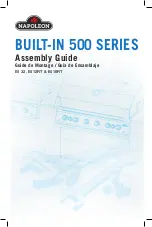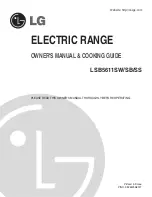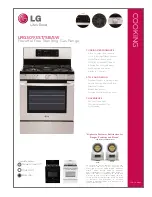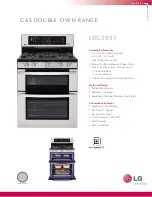
27
Notes about Convection Cooking:
Convection cooking generally provides a more even temperature with
faster baking times than the standard oven baking setting. When baking in
Convection Mode, either reduce the temperature stated in the recipe and
leave the baking time unchanged, or reduce the baking time by several
minutes and leave the temperature unchanged. For foods with a baking time
of over an hour, reducing both the temperature and the time slightly may give
the best results.
• Dark metal baking pans or those with a dull finish absorb heat faster than
shiny pans, and are excellent for pies, breads and anything that needs
browning or a crisper crust.
• Shiny finish or light coloured pans may work best for foods that require
lighter, more delicate browning or a crisper crust as they reflect some heat,
creating a less intense baking surface.
• Avoid opening the oven door frequently during baking as this affects
temperature and efficiency.
Convection Roasting:
When convection roasting, it is important that you use a broiler pan for best
convection roasting results. A broil/roast pan (with a rack) elevates the roast
to allow the hot air to circulate around the meat, sealing in juices for a moist
and tender roast with a richly browned exterior (similar to a rotisserie effect.)
The pan is also used to catch any drippings from the roast, keeping the oven
clean and reducing the chance of smoking or flare-ups.
The convection fan circulates heated air evenly over and around the food,
sealing in juices for a moist and tender roast with a richly browned exterior.
Convection Defrost:
With the temperature control off, a motorized fan in the rear of the oven
circulates air. The fan accelerates natural defrosting of the food without heat.
To avoid bacteria growth, food-borne illness and food waste, do not allow
defrosted food to remain in the oven for more than 2 hours without being
cooked.
Convection Dehydrate:
With the temperature control at 175˚F, warm air is radiated from the bake
burners in the bottom of the oven cavity and is circulated by a motorized fan
in the rear of the oven. Over time, this constant circulating heat evaporates
moisture from food, which inhibits bacteria growth and halts enzyme activity.
OVEN USE continued
















































